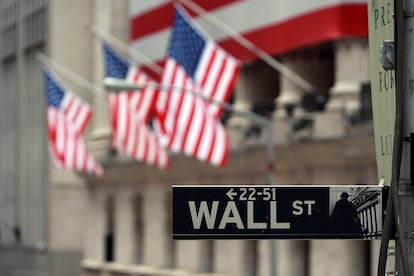Large US banks grow their profits due to rise in interest rates
JPMorgan, Bank of America, Wells Fargo, Citi and Goldman Sachs earn 20% more in the third quarter of the year


The numbers add up on Wall Street. After the financial turmoil of the first half of the year, the large U.S. banks have closed the third quarter with record profits thanks to the rise in interest rates and the fact that the feared recession has yet to happen. Large groups have managed to charge more for their loans while barely raising the interest rate on deposits. At the same time, they have had to make fewer provisions than expected. Even the investment banking sector is beginning to breathe a sigh of relief after last year’s financial disaster thanks to an increase in IPOs and corporate operations.
JPMorgan, Bank of America, Wells Fargo, Citi and Goldman Sachs achieved an aggregate profit of $34 billion (about €32.2 billion at the current exchange rate) in the third quarter of 2023, 17% more than in the same period last year. JPMorgan has achieved record third-quarter results and for the accumulated first nine months of the year. Wells Fargo is close to its record for the third quarter, although the nine-month result is far from its best years. Bank of America posted a 10% rise in third quarter profits. In contrast, Citi has not yet recovered from last year’s profit decline and Goldman Sachs is once again suffering a decline in profits, mainly due to its exposure to the real estate sector, just like Morgan Stanley, which is still feeling the impact of its investment banking operations.
The great winner in the current scenario is JPMorgan Chase, the largest bank in the United States, which has expanded its advantage over the rest in terms of size and profits. The bank led by Jamie Dimon reported $13.2 billion profit in the third quarter, up 35% from the same period in 2022. JPMorgan emerged stronger from the shock to the financial sector caused by the fall of Silicon Valley Bank, which was followed by other medium-sized entities. Depositors sought the security of large banks, which served to contain the cost of their liabilities. Furthermore, JPMorgan ended up bailing out First Republic in very good conditions and is benefiting from it.
Despite this, Dimon was cautious in his conference with analysts: “My caution is that we are facing so many uncertainties out there,” he said, warning that “this may be the most dangerous time the world has seen in decades.”
Bank of America, the second-largest bank, has also managed to gain ground at the expense of weaker entities. “We have added clients and accounts in all lines of business. We did this in a healthy but slowing economy that saw U.S. consumer spending still ahead of last year but continuing to slow,” said CEO Brian Moynihan in a statement.
The bank earned a profit of $7.8 billion, up 11% from the same period in 2022 and the highest figure for a third quarter since 2010. The rise in interest rates was the driver of that boost in profits, although this rate increase has a counterpart that has penalized Bank of America on the stock market, where it accumulates heavy losses in its portfolio of bonds held until maturity. These are losses that are not recognized in the profits report because the bank plans to hold the bonds until they are redeemed, but they imply a high opportunity cost. These unrealized losses increased to $131 billion in the third quarter, compared to $116 billion in the same period of 2022. It was losses of this type that got entities with weaker balance sheets than Bank of America into trouble.
Mortgage leader change
The largest relative increase in profit in the third quarter was achieved by Wells Fargo, which earned $5.8 billion, up 61% from the same period last year. Of the large lenders, it is the bank that benefited the most from the rise in interest rates, which boosted its interest margin by 8% to $13 billion and total earnings by 7% to $20.9 billion. Added to this was a lower need for provisions, which reduced the cost of credit for the San Francisco-based bank.
For its part, Citi improved its results by 2%, to $3.6 billion in the third quarter, thanks to strong growth driven by increases in interest rates and by the trading of fixed-income securities and currencies. CEO Jane Fraser has launched a company-wide reorganization that focuses on five key segments: trading, banking, wealth management, services and personal banking in the United States.
Goldman Sachs, meanwhile, has had eight consecutive quarters of year-on-year decline in profits. The entity has been the most affected by the collapse in earnings for the investment banking sector, to which has been added a failed attempt at consumer lending. The company saw its third-quarter earnings fall 33% to $1.9 million. Earnings were $2.06 billion, down from a profit of $3.07 billion in the same period a year ago. The bank is selling off its GreenSky business, which the bank had to write off this quarter.
“We’re confident that the work we’re doing now provides us a much stronger platform for 2024,” said David Solomon, chairman and CEO, in a statement.
Sign up for our weekly newsletter to get more English-language news coverage from EL PAÍS USA Edition
Tu suscripción se está usando en otro dispositivo
¿Quieres añadir otro usuario a tu suscripción?
Si continúas leyendo en este dispositivo, no se podrá leer en el otro.
FlechaTu suscripción se está usando en otro dispositivo y solo puedes acceder a EL PAÍS desde un dispositivo a la vez.
Si quieres compartir tu cuenta, cambia tu suscripción a la modalidad Premium, así podrás añadir otro usuario. Cada uno accederá con su propia cuenta de email, lo que os permitirá personalizar vuestra experiencia en EL PAÍS.
¿Tienes una suscripción de empresa? Accede aquí para contratar más cuentas.
En el caso de no saber quién está usando tu cuenta, te recomendamos cambiar tu contraseña aquí.
Si decides continuar compartiendo tu cuenta, este mensaje se mostrará en tu dispositivo y en el de la otra persona que está usando tu cuenta de forma indefinida, afectando a tu experiencia de lectura. Puedes consultar aquí los términos y condiciones de la suscripción digital.
More information
Archived In
Últimas noticias
Most viewed
- Sinaloa Cartel war is taking its toll on Los Chapitos
- Oona Chaplin: ‘I told James Cameron that I was living in a treehouse and starting a permaculture project with a friend’
- Reinhard Genzel, Nobel laureate in physics: ‘One-minute videos will never give you the truth’
- Why the price of coffee has skyrocketed: from Brazilian plantations to specialty coffee houses
- Silver prices are going crazy: This is what’s fueling the rally










































